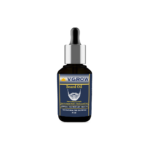No products added!
Minoxidil, originally developed as an oral medication for hypertension, has become a popular topical treatment for hair loss. However, its use is associated with potential systemic absorption and unintended side effects, including unwanted hair growth on various body parts. This article explores the origins of minoxidil, its absorption dynamics, and the risks of generalized hypertrichosis resulting from its use.
The Origins of Minoxidil: From Hypertension to Hair Growth
In the 1970s, minoxidil was introduced as an oral treatment for high blood pressure. Patients using the medication often experienced excessive hair growth (hypertrichosis) as a side effect. This observation led to the development of topical minoxidil formulations aimed at treating hair loss conditions such as androgenetic alopecia.
The Hidden Dangers of Using Minoxidil for Hair Growth


Systemic Absorption of Topical Minoxidil
While topical application targets the scalp, studies have shown that minoxidil can be absorbed into the bloodstream. Approximately 1.4% of the applied dose is absorbed through a healthy scalp, with factors like concentration, frequency of application, and scalp condition influencing absorption rates. Although this percentage seems low, even minimal systemic absorption can lead to unintended effects.
Unintended Consequences: Generalized Hypertrichosis
Systemic absorption of minoxidil can result in hypertrichosis beyond the intended treatment area. Several cases have been documented:PMC+1The US Sun
Adult Cases: A 26-year-old woman developed generalized hypertrichosis eight weeks after using 5% topical minoxidil for alopecia areata. The excessive hair growth appeared on her face, upper limbs, and trunk. The condition resolved after discontinuing the medication. PubMed+1PMC
Pediatric Cases: A 3-year-old boy treated with 5% minoxidil lotion for alopecia areata developed severe hypertrichosis on the forehead, cheeks, and neck after two months of unsupervised application. The hypertrichosis subsided after stopping the treatment. PMC
Infant Cases: In Europe, eleven infants developed hypertrichosis, known as “werewolf syndrome,” after exposure to topical minoxidil through skin-to-skin contact with caregivers using the medication. The excessive hair growth resolved once exposure ceased. People.com
The Vicious Cycle: From Hair Growth to Hair Removal
The unintended side effect of generalized hypertrichosis can lead individuals to seek additional treatments, such as laser hair removal, to manage unwanted hair growth. This situation creates a cycle where the initial use of minoxidil for scalp hair growth results in further cosmetic concerns and interventions, leading to increased physical, emotional, and financial burdens.
Rethinking the Use of Minoxidil for Hair Regrowth
Given the potential for systemic absorption and subsequent side effects, it is crucial to weigh the risks and benefits of using topical minoxidil. Consulting with healthcare professionals to explore alternative treatments for hair loss is advisable. Options such as lifestyle modifications, nutritional supplementation, and other medical therapies may offer safer solutions without the risk of unintended systemic effects.
While minoxidil has proven effective for promoting scalp hair growth, its potential for systemic absorption and the risk of generalized hypertrichosis warrant caution. Awareness of these risks is essential to prevent falling into a cycle of continuous treatments and unintended consequences. Prioritizing holistic approaches and consulting healthcare professionals can help individuals make informed decisions about hair loss treatments.












